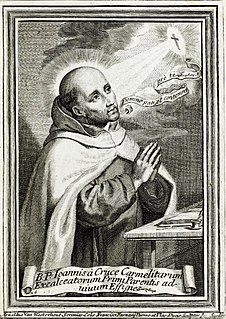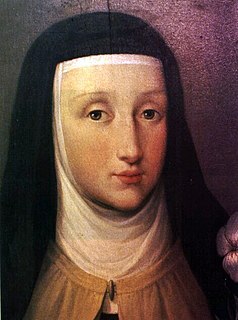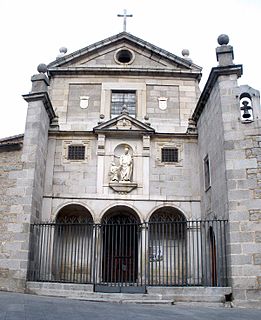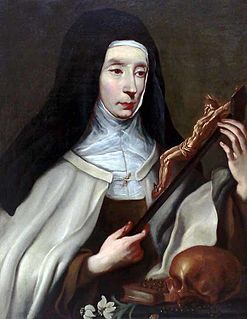
The Carmelites, formally known as the Order of the Brothers of the Blessed Virgin Mary of Mount Carmel or sometimes simply as Carmel by synecdoche, is a Roman Catholic mendicant religious order for men and women. Historical records about its origin remain very uncertain, but it was probably founded in the 12th century on Mount Carmel in the Crusader States. Berthold of Calabria has traditionally been associated with the founding of the order, but few clear records of early Carmelite history have survived. The order of Carmelite nuns was formalised in 1452.

Teresa of Ávila, born Teresa Sánchez de Cepeda y Ahumada, also called Saint Teresa of Jesus, was a Spanish noblewoman who felt called to convent life in the Catholic Church. A Carmelite nun, prominent Spanish mystic, religious reformer, author, theologian of the contemplative life and of mental prayer, she earned the rare distinction of being declared a Doctor of the Church, but not until over four centuries after her death. Active during the Catholic Reformation, she reformed the Carmelite Orders of both women and men. The movement she initiated was later joined by the younger Spanish Carmelite friar and mystic John of the Cross. It led eventually to the establishment of the Discalced Carmelites. A formal papal decree adopting the split from the old order was issued in 1580.

John of the Cross, venerated as Saint John of the Cross, was a Spanish Catholic priest, mystic, and a Carmelite friar of converso origin. He is a major figure of the Counter-Reformation in Spain, and he is one of the thirty-six Doctors of the Church.

Blanche of Portugal, was an infanta, the firstborn child of King Afonso III of Portugal and his second wife Beatrice of Castile. Named after her great-aunt Blanche of Castile, queen of France, Blanche was the Lady of Las Huelgas, Montemor-o-Velho, Alcocer and Briviesca, the city which she founded.

Infanta Maria Teresa of Braganza was the firstborn child of John VI of Portugal and Carlota Joaquina of Spain, and heir presumptive to the throne of Portugal between 1793 and 1795, until her short-lived brother António Pio was born.

Infanta Isabel Maria of Braganza ; Queluz, 4 July 1801 – Benfica, then Belém, 22 April 1876 was a Portuguese infanta (princess) and fourth daughter of King John VI of Portugal and his wife Carlota Joaquina of Spain. She acted as regent for two years.

Teresa of Jesus of Los Andes - born as Juana Fernández Solar - was a Chilean professed religious from the Discalced Carmelites. Fernández Solar was a pious child but had an often unpredictable temperament for she could be prone to anger and being vain but could also demonstrate her charitable and loving nature; she seemed transformed when she decided to become a nun and her character seemed to change for her sole ambition was to dedicate herself to the service of God. But her time in the convent was cut short due to her contracting an aggressive disease that killed her - she knew she would die but was consoled knowing she would be able to make her profession before she died.
Carlos O'Neill, was the titular head of a branch of the Clanaboy O'Neill dynasty, whose family has been based in Portugal since the 18th century.

The Estrela Basilica or the Royal Basilica and Convent of the Most Sacred Heart of Jesus, is a minor basilica and ancient carmelite convent in Lisbon, Portugal.

Teresa Margaret of the Sacred Heart, O.C.D. was an Italian Discalced Carmelite nun. During her brief life of quiet service in the monastery, she came to be revered for her mystical gifts. She has been declared a saint by the Catholic Church.

Francisco de Matos Vieira, better known as Vieira Lusitano was a Portuguese court painter, illustrator and engraver.

The Convento de San José is a monastery of Discalced Carmelite nuns in Ávila, Spain. It is situated not far from the center of the city but outside the medieval walls. Saint Teresa of Jesus was the driving force behind the foundation of the monastery, which was built from 1562 onwards. The church was only begun in 1607 after Saint Teresa's death. The statue in the facade was commissioned by King Philip III of Spain via artist Giraldo de Merlo.

The House of Abrantes descends from the ancient and noble Almeida family.

Lúcia de Jesus Rosa dos Santos, O.C.D., also known as Lúcia of Fátima and by her religious name Sister Maria Lúcia of Jesus and of the Immaculate Heart, was a Portuguese Catholic Discalced Carmelite nun, one of the three children, along with her cousins Francisco and Jacinta Marto, who claimed to have witnessed Marian apparitions in Fátima in 1917.

The Pantheon of the House of Braganza, also known as the Pantheon of the Braganzas, is the final resting place for many of the members of the House of Braganza, located in the Monastery of São Vicente de Fora in the Alfama district of Lisbon, Portugal. The pantheon's burials have included Portuguese monarchs, Brazilian monarchs, a Romanian monarch, queen consorts of Portugal, and notable Infantes of Portugal, among others.

A Church of São João Evangelista, or Carmelite Church of Aveiro, is an 18th-century church in the Praça Marquês de Pombal, in the civil parish of Glória e Vera Cruz, in the Portuguese municipality of Aveiro. It was declared a national monument in 1910.

Julio Xavier Labayen OCD STL JCL DD was a Filipino Discalced Carmelite and a Roman Catholic bishop. Ordained to the priesthood in 1955, he served as bishop of the Territorial Prelature of Infanta, Philippines from 1966 until 2003. He was among the first Filipino Discalced Carmelites in the 1950s. He was the first Filipino Discalced Carmelite bishop and the second bishop of the Prelature of Infanta.

Marianna Fontanella – in religious Maria degli Angeli – was an Italian Roman Catholic professed religious from the Discalced Carmelites. Fontanella studied with the Cistercians as a child and entered the Discalced Carmelites despite the protests of her mother and siblings – she soon became a noted abbess and prioress and in 1703 inaugurated a new convent she herself oversaw the establishment of.

Mother Paula of Odivelas, religious name of Paula Teresa da Silva e Almeida, was a Portuguese nun and royal mistress.



















